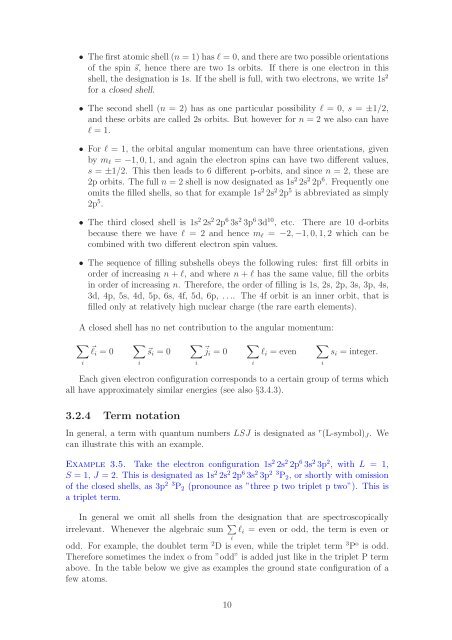Thermal X-ray radiation (PDF) - SRON
Thermal X-ray radiation (PDF) - SRON
Thermal X-ray radiation (PDF) - SRON
You also want an ePaper? Increase the reach of your titles
YUMPU automatically turns print PDFs into web optimized ePapers that Google loves.
• The first atomic shell (n = 1) has l = 0, and there are two possible orientations<br />
of the spin ⃗s, hence there are two 1s orbits. If there is one electron in this<br />
shell, the designation is 1s. If the shell is full, with two electrons, we write 1s 2<br />
for a closed shell.<br />
• The second shell (n = 2) has as one particular possibility l = 0, s = ±1/2,<br />
and these orbits are called 2s orbits. But however for n = 2 we also can have<br />
l = 1.<br />
• For l = 1, the orbital angular momentum can have three orientations, given<br />
by m l = −1, 0, 1, and again the electron spins can have two different values,<br />
s = ±1/2. This then leads to 6 different p-orbits, and since n = 2, these are<br />
2p orbits. The full n = 2 shell is now designated as 1s 2 2s 2 2p 6 . Frequently one<br />
omits the filled shells, so that for example 1s 2 2s 2 2p 5 is abbreviated as simply<br />
2p 5 .<br />
• The third closed shell is 1s 2 2s 2 2p 6 3s 2 3p 6 3d 10 , etc. There are 10 d-orbits<br />
because there we have l = 2 and hence m l = −2, −1, 0, 1, 2 which can be<br />
combined with two different electron spin values.<br />
• The sequence of filling subshells obeys the following rules: first fill orbits in<br />
order of increasing n + l, and where n + l has the same value, fill the orbits<br />
in order of increasing n. Therefore, the order of filling is 1s, 2s, 2p, 3s, 3p, 4s,<br />
3d, 4p, 5s, 4d, 5p, 6s, 4f, 5d, 6p, . . .. The 4f orbit is an inner orbit, that is<br />
filled only at relatively high nuclear charge (the rare earth elements).<br />
A closed shell has no net contribution to the angular momentum:<br />
∑<br />
⃗l i = 0<br />
i<br />
∑<br />
⃗s i = 0<br />
i<br />
∑<br />
⃗j i = 0<br />
i<br />
∑<br />
l i = even<br />
i<br />
∑<br />
s i = integer.<br />
Each given electron configuration corresponds to a certain group of terms which<br />
all have approximately similar energies (see also §3.4.3).<br />
3.2.4 Term notation<br />
In general, a term with quantum numbers LSJ is designated as r (L-symbol) J . We<br />
can illustrate this with an example.<br />
Example 3.5. Take the electron configuration 1s 2 2s 2 2p 6 3s 2 3p 2 , with L = 1,<br />
S = 1, J = 2. This is designated as 1s 2 2s 2 2p 6 3s 2 3p 2 3 P 2 , or shortly with omission<br />
of the closed shells, as 3p 2 3 P 2 (pronounce as ”three p two triplet p two”). This is<br />
a triplet term.<br />
In general we omit all shells from the designation that are spectroscopically<br />
irrelevant. Whenever the algebraic sum ∑ l i = even or odd, the term is even or<br />
i<br />
odd. For example, the doublet term 2 D is even, while the triplet term 3 P o is odd.<br />
Therefore sometimes the index o from ”odd” is added just like in the triplet P term<br />
above. In the table below we give as examples the ground state configuration of a<br />
few atoms.<br />
i<br />
10
















